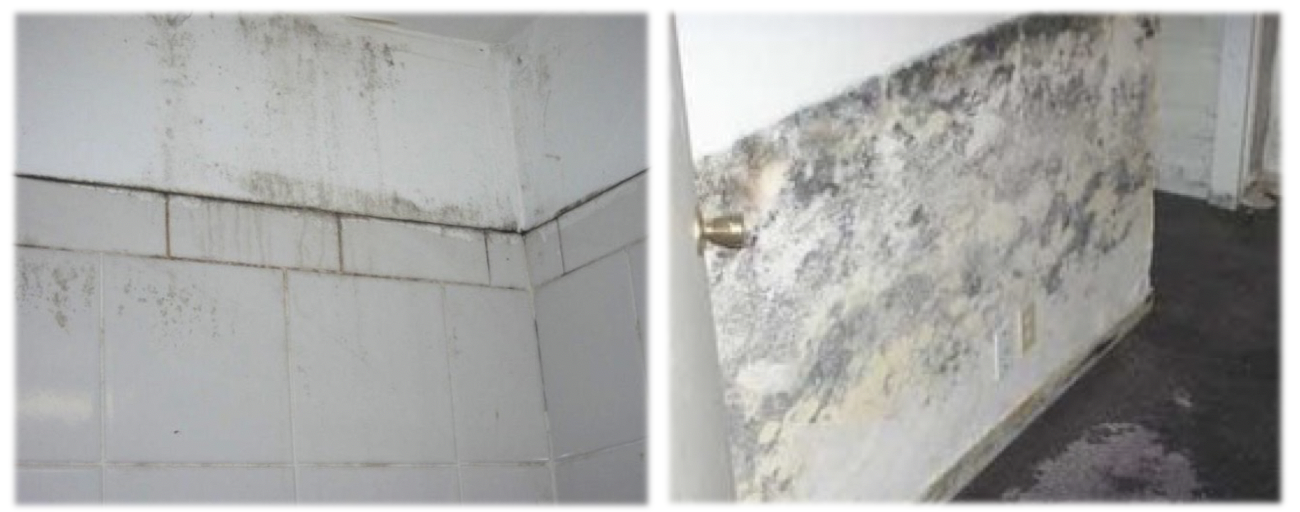Moisture Control
New ResidentialWhat is Moisture Control?
Moisture control is a strategy to minimize excessive moisture in the indoor environment. Excess moisture is at the center of many problems related to building durability and indoor air quality in all types of buildings in a wide range of climates. Excessive moisture in buildings can result from many causes: [1]
- Rainwater leaks through roofs and walls
- Leakage of moist air
- Diffusion of moisture through walls, roofs, and floors
- Groundwater intrusion into basements and crawl spaces through walls and floors
- Leaking or burst water pipes
- Indoor moisture sources
- Construction moisture

Figure 1 – Humidity can lead to mold. ( Source: Rutgers Center for Green Building)
Moisture problems can lead to the growth of mold and mildew; individuals with allergies and other respiratory issues can be sensitive to mold and mildew spores in the air. Mold and mildew are part of the natural environment and are present in the air; however, they become an issue when their concentrations become high. It is challenging to prevent any mold or mildew growth, or to eliminate it; however, it is possible to control their presence within acceptable limits. In addition to mold, other microorganisms (e.g., bacteria), as well as pests (e.g., mites, cockroaches, and insects) that are known to infest buildings also depend on moisture to survive. Excessively high moisture content in thermal insulation can also reduce the effectiveness of insulation by as much as 50%.[2] Implementing moisture control can both protect structures from rot and deterioration and protect occupants from exposure to mold and bacteria.[3]
According to the US Environmental Protection Agency, the following are primary causes of indoor moisture problems in new buildings:[4]
- Use of building materials that are repeatedly or deeply wetted before the structure. is fully enclosed.
- Poor control of rain and snow resulting in roof and flashing leaks.
- Wet or damp construction cavities.
- Moisture-laden outdoor air entering the structure.
- Condensation on cool surfaces.
How to Implement Moisture Control
Proper construction of the envelope to reduce the migration of warm and humid air from entering the wall and other cavities is critical for controlling moisture. The envelope is the physical barrier between indoors and outdoors that encloses the structure, including the foundation, roof, floor, ceiling, and walls.[5] Specific recommendations include proper use of vapor retarders on the warm, humid side of the insulation, using vapor barriers to isolate concrete slabs from moist soil, adequate ventilation of areas where moisture can accumulate, and ensuring proper flashing around windows, rooflines, and capillary breaks on footings.
Key strategies for reducing moisture in new construction include:[6]
- Keeping construction material dry before installation (and drying any materials that get wet within 24-48 hours).
- Designing roof systems that prevent the accumulation of moisture from rain and snow from penetrating roof surfaces.
- Ensuring fresh air intakes for ventilation system have outwardly sloped louvers to reduce the introduction of water during rainfall.
- Grading the soil around the residence to move water away from the structure, reducing moisture seepage into foundation walls, and avoiding the addition of large areas of impervious surfaces (which can increase the cost and size of stormwater management systems).
- Incorporating covered entryways to reduce moisture introduction during wet weather.
- Right-sizing HVAC systems so that they operate long enough to reduce airborne humidity.
- Using dehumidifiers.
- Insulating ductwork, refrigeration and water lines to minimize condensation problems.
Example
The Harrison Residence, Westfield, NJ
This residential project achieved LEED for Homes Gold certification and included an excellent indoor environmental score in part due to comprehensive HVAC design that included moisture control measures.
Benefits
- Increases the longevity of the structure, materials, and systems
- Reduces the costs of replacing or repairing materials and systems
- Protects the health of building occupants
- Reduces life-cycle costs
Costs
In addition to contributing to poor indoor air quality, excessive moisture can lead to structural damage, deterioration of the performance of building systems and components, and cosmetic damage, all of which can result in increased maintenance and repair costs. Designing for effective moisture management protects occupant health and can lower facility maintenance costs over the lifetime of the structure.[7]
Resiliency
Strategies such as complete waterproofing up to the design flood elevation, using moisture protective and inherent moisture-wicking materials, as well as materials resistant to excessive humidity such as glazed brick, concrete, stone, and decay-resistant lumber can all contribute to more resilient structures. Incorporating moisture control measures such as these into new construction can help develop a built environment that endures and recovers from hazardous events such as storms and flooding.[8]
[1] Whole Building Design Guide. Mold and Moisture Dynamics. http://www.wbdg.org/resources/moisturedynamics.php?r=promote_health (accessed December 1, 2018).
[2] Whole Building Design Guide. Mold and Moisture Dynamics http://www.wbdg.org/resources/moisturedynamics.php?r=promote_health (accessed May 21, 2018).
[3] Whole Building Design Guide. http://www.wbdg.org/resources/moisturedynamics.php?r=promote_health (accessed May 21, 2018).
[4] US EPA – Moisture Control, Part of Indoor Air Quality Design Tools for Schools https://www.epa.gov/iaq-schools/moisture-control-part-indoor-air-quality-design-tools-schools (accessed May 21, 2018)
[5] USDOE. Better Buildings Initiative. Building Envelope. https://betterbuildingsinitiative.energy.gov/alliance/technology-solution/building-envelope (accessed November 21, 2018).
[6]US EPA. Moisture Control for Building Design, Construction, and Maintenance. https://www.epa.gov/sites/production/files/2014-08/documents/moisture-control.pdf (accessed December 1, 2018).
[7] The National Academies Press. Building Envelope, Moisture Management, and Health. http://www.nap.edu/openbook.php?record_id=11574&page=25 (accessed May 21, 2018).
[8] Whole Building Design Guide. Hazard-Specific Building-Resilience Considerations. https://www.wbdg.org/resources/hazard-specific-building-resilience-considerations (accessed December 1, 2018).
Related Strategies
Resources
- General Services Administration – Sustainable Facilities Tool – Moisture Control
- IAQ Building Education and Assessment Model (I-BEAM)
- Moisture Control in Buildings: Putting Building Science in Green Building
- NJ Department of Health – Environmental and Indoor Health
- US EPA Indoor Air Quality in Offices and Other Large Buildings
- US EPA Moisture Control for Building Design, Construction and Maintenance
- US EPA – Topics Related to Mold and Moisture
- US EPA – Weatherize – Moisture Control
- Whole Building Design Guide – Hazard-Specific Building-Resilience Considerations
- Whole Building Design Guide – Promote Health and Well-Being
